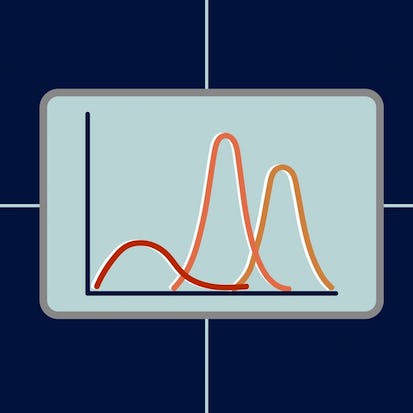- Level Professional
- Duration 12 hours
- Course by University of California, Santa Cruz
-
Offered by

About
This course introduces the Bayesian approach to statistics, starting with the concept of probability and moving to the analysis of data. We will learn about the philosophy of the Bayesian approach as well as how to implement it for common types of data. We will compare the Bayesian approach to the more commonly-taught Frequentist approach, and see some of the benefits of the Bayesian approach. In particular, the Bayesian approach allows for better accounting of uncertainty, results that have more intuitive and interpretable meaning, and more explicit statements of assumptions. This course combines lecture videos, computer demonstrations, readings, exercises, and discussion boards to create an active learning experience. For computing, you have the choice of using Microsoft Excel or the open-source, freely available statistical package R, with equivalent content for both options. The lectures provide some of the basic mathematical development as well as explanations of philosophy and interpretation. Completion of this course will give you an understanding of the concepts of the Bayesian approach, understanding the key differences between Bayesian and Frequentist approaches, and the ability to do basic data analyses.Modules
Module overview
1
Videos
- Course introduction
1
Readings
- Module 1 objectives, assignments, and supplementary materials
Probability
1
Assignment
- Lesson 1: Demonstrate your knowledge
1
Discussions
- Objectivity
2
Videos
- Lesson 1.1 Classical and frequentist probability
- Lesson 1.2 Bayesian probability and coherence
1
Readings
- Background for Lesson 1
Bayes' theorem
1
Assignment
- Lesson 2: Demonstrate your knowledge
2
Videos
- Lesson 2.1 Conditional probability
- Lesson 2.2 Bayes' theorem
1
Readings
- Supplementary material for Lesson 2
Review of distributions
2
Assignment
- Lesson 3.1: Demonstrate your knowledge
- Lesson 3.2-3.3: Demonstrate your knowledge
3
Videos
- Lesson 3.1 Bernoulli and binomial distributions
- Lesson 3.2 Uniform distribution
- Lesson 3.3 Exponential and normal distributions
1
Readings
- Supplementary material for Lesson 3
Probability and Bayes' theorem
1
Assignment
- Module 1 Honors
Module overview
1
Readings
- Module 2 objectives, assignments, and supplementary materials
Frequentist inference
1
Assignment
- Lesson 4: Demonstrate your knowledge
7
Videos
- Lesson 4.1 Confidence intervals
- Lesson 4.2 Likelihood function and maximum likelihood
- Lesson 4.3 Computing the MLE
- Lesson 4.4 Computing the MLE: examples
- Introduction to R
- Plotting the likelihood in R
- Plotting the likelihood in Excel
2
Readings
- Background for Lesson 4
- Supplementary material for Lesson 4
Bayesian inference
2
Assignment
- Lesson 5.1-5.2: Demonstrate your knowledge
- Lesson 5.3-5.4: Demonstrate your knowledge
1
Discussions
- Confidence intervals and credible intervals
4
Videos
- Lesson 5.1 Inference example: frequentist
- Lesson 5.2 Inference example: Bayesian
- Lesson 5.3 Continuous version of Bayes' theorem
- Lesson 5.4 Posterior intervals
2
Readings
- Background for Lesson 5
- Supplementary material for Lesson 5
Statistical inference
1
Assignment
- Module 2 Honors
Module overview
1
Readings
- Module 3 objectives, assignments, and supplementary materials
Priors
1
Assignment
- Lesson 6: Demonstrate your knowledge
3
Videos
- Lesson 6.1 Priors and prior predictive distributions
- Lesson 6.2 Prior predictive: binomial example
- Lesson 6.3 Posterior predictive distribution
Bernoulli/binomial data
1
Assignment
- Lesson 7: Demonstrate your knowledge
1
Discussions
- Prior elicitation
5
Videos
- Lesson 7.1 Bernoulli/binomial likelihood with uniform prior
- Lesson 7.2 Conjugate priors
- Lesson 7.3 Posterior mean and effective sample size
- Data analysis example in R
- Data analysis example in Excel
1
Readings
- R and Excel code from example analysis
Poisson data
1
Assignment
- Lesson 8: Demonstrate your knowledge
1
Videos
- Lesson 8.1 Poisson data
Priors and models for discrete data
1
Assignment
- Module 3 Honors
Module overview
1
Readings
- Module 4 objectives, assignments, and supplementary materials
Exponential data
1
Assignment
- Lesson 9: Demonstrate your knowledge
1
Videos
- Lesson 9.1 Exponential data
Normal data
1
Assignment
- Lesson 10: Demonstrate your knowledge
2
Videos
- Lesson 10.1 Normal likelihood with variance known
- Lesson 10.2 Normal likelihood with variance unknown
1
Readings
- Supplementary material for Lesson 10
Alternative priors
1
Assignment
- Lesson 11: Demonstrate your knowledge
1
Discussions
- A non-informative prior
2
Videos
- Lesson 11.1 Non-informative priors
- Lesson 11.2 Jeffreys prior
1
Readings
- Supplementary material for Lesson 11
Linear regression
1
Assignment
- Regression: Demonstrate your knowledge
3
Videos
- Linear regression in R
- Linear regression in Excel (Analysis ToolPak)
- Linear regression in Excel (StatPlus by AnalystSoft)
2
Readings
- Background for Lesson 12
- R and Excel code for regression
Course conclusion
1
Videos
- Conclusion
Models for continuous data
1
Assignment
- Module 4 Honors
Auto Summary
Discover the Bayesian approach to statistics with this comprehensive course in Data Science & AI, led by Coursera. Dive into probability concepts, data analysis, and compare Bayesian with Frequentist methods. Enjoy a blend of lectures, computer demos, and interactive content, using either Microsoft Excel or R. Perfect for professionals, the course spans 720 minutes and offers Starter, Professional, and Paid subscription options.

Herbert Lee

